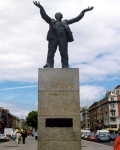Statues
Archaeology »
Archaeological Monuments » Statues
Statues - Ireland
Statues is located in Dublin.
Statues monument was established on 1966.
Primary threats to Statues :
Dublin's most prominent monument, Nelson's Pillar, which stood near the General Post Office (GPO) in the centre of O'Connell Street, was blown up by Saor Eire in 1966, as their way of commemorating the Easter Rising.
Historical facts of Statues :
- Introduction :
Statues and monuments have long been a quintessential form of art and expression that immortalizes historical events, important figures, and cultural values. One such significant statue monument was established in 1966, leaving an indelible mark on history. In this essay, we will explore the historical significance of this iconic monument and delve into the events leading to its creation.
- Establishment of the Statue Monument :
In 1966, a group of visionary artists and civic leaders came together to commemorate a pivotal event in the nation's history. This event was a turning point that shaped the destiny of a nation and its people. The idea was to erect a monument that would serve as a symbol of unity, strength, and the resilience of the people.
- The monument's location was carefully chosen, strategically placed in a prominent public space that allowed it to be visible from various parts of the city. Its central position ensured that it became an integral part of the urban landscape, evoking a sense of pride and identity among the citizens.
- Historical Facts and Symbolism :
Commemoration of a National Triumph:
The monument was designed to honor a significant historical victory that changed the course of the nation's history. It celebrated the valor and sacrifice of those who fought for freedom, justice, and independence, making it a powerful symbol of national triumph and identity.
- Artistic Design and Architecture :
The statue monument's design and architecture were carefully crafted to encapsulate the essence of the event it commemorated. The artists behind its creation worked diligently to incorporate elements that represented the struggles, aspirations, and achievements of the people, leaving behind a timeless masterpiece.
- Uniting the Nation :
The monument aimed to transcend regional and cultural differences, serving as a unifying force for the diverse population of the nation. By highlighting the shared values and history of the people, it instilled a sense of belonging and national pride in every citizen, fostering a spirit of unity.
- Historical Context :
The establishment of the monument coincided with a period of societal transformation and political changes. It served as a testament to the progress made and reminded people of the challenges they had overcome. The statue became a living reminder of the nation's resilience in times of adversity.
- Cultural Significance :
Beyond its historical context, the monument also held immense cultural significance. It became a symbol of cultural heritage and a representation of the artistic achievements of the nation. Artists and historians alike recognized its importance in preserving the memory of past events for future generations.
- Communal Gathering Space :
Over the years, the statue monument transformed into a communal gathering space. People from all walks of life would come together to celebrate national holidays, commemorate important anniversaries, and participate in civic events. It became a place where citizens connected with their shared past and envisioned a collective future.
- Tourist Attraction :
The statue monument became an iconic landmark, attracting tourists from across the globe. Visitors marveled at its grandeur, learned about the nation's history, and appreciated the artistic brilliance that went into its creation. It became an essential part of the nation's tourism industry, contributing to the economy and cultural exchange.
- Conclusion :
The statue monument established in 1966 stands as a testament to the power of art, history, and unity. Over the years, it has played a pivotal role in shaping the national identity and inspiring generations with its symbolism and significance. As an enduring reminder of the nation's past triumphs, the monument continues to stand tall, inviting people to reflect on their shared history and embrace a brighter future together.

